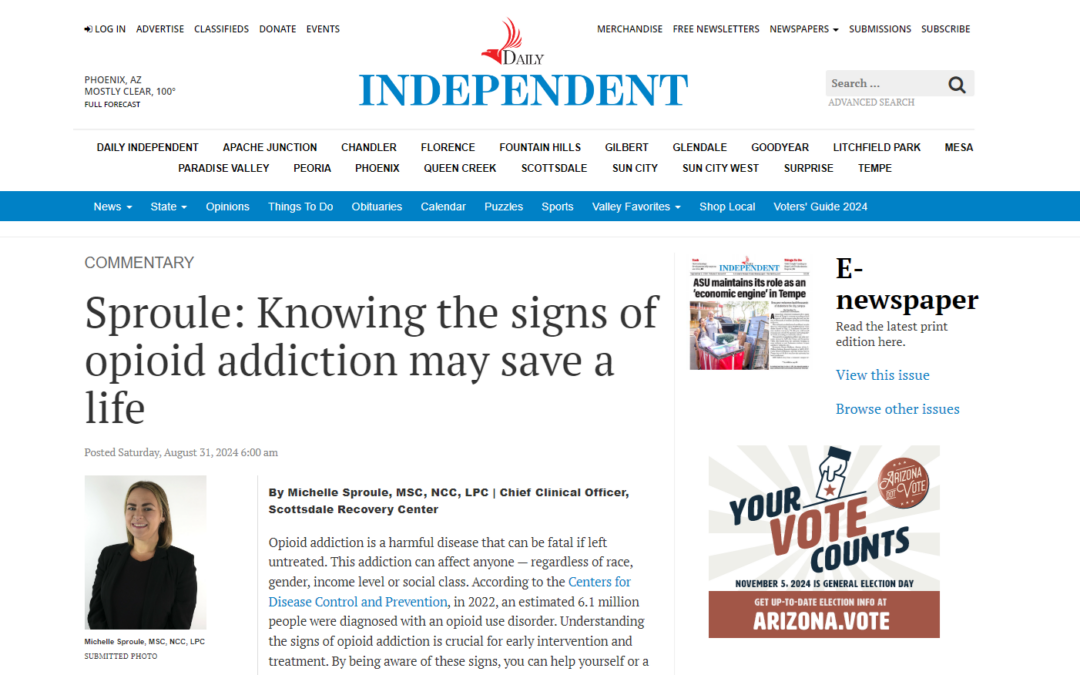Opioid addiction is a harmful disease that can be fatal if left untreated. This addiction can affect anyone — regardless of race, gender, income level or social class. According to the Centers for Disease Control and Prevention, in 2022, an estimated 6.1 million people were diagnosed with an opioid use disorder. Understanding the signs of opioid addiction is crucial for early intervention and treatment. By being aware of these signs, you can help yourself or a loved one get the necessary help and support to overcome addiction.
Understanding opioid addiction
Opioids are a class of drugs that include prescription painkillers such as oxycodone, hydrocodone, morphine and fentanyl, as well as illegal drugs like heroin and synthetic (non-prescribed) fentanyl. These substances are highly addictive due to their potent effects on the brain’s reward system. Opioid addiction, also known as opioid use disorder, is characterized by the compulsive use of opioids despite harmful consequences.
Here are the top 10 signs of opioid addiction:
Increased tolerance
One of the earliest signs of opioid addiction is the development of tolerance. This means that over time, the individual needs higher doses of the drug to achieve the same effects that were previously attained with lower doses. Tolerance occurs because the brain becomes accustomed to the presence of opioids, and the body’s natural opioid receptors become less responsive. As a result, the person may increase their dosage to experience the desired effects, which can lead to a dangerous cycle of escalating use.
Withdrawal symptoms
Withdrawal symptoms occur when an individual who is dependent on opioids reduces their use or stops using the drug altogether. These symptoms can be both physical and psychological.
Common withdrawal symptoms include nausea and vomiting, diarrhea, muscle and bone pain, anxiety and irritability, sweating and chills, and insomnia
Withdrawal symptoms are a clear sign of physical dependence on opioids. They occur because the body has become reliant on the drug to function normally, and the sudden absence of opioids causes a physiological imbalance.
Cravings
Intense cravings for opioids are a hallmark of addiction. These cravings can be overwhelming and persistent, driving individuals to seek out and use the drug despite knowing the negative consequences. Cravings are driven by changes in the brain’s reward system, where the use of opioids creates a powerful association between the drug and pleasure. This association can trigger intense desires to use the drug, making it difficult for individuals to resist.
Neglecting responsibilities
Individuals with opioid addiction often neglect their responsibilities at work, school, or home. This can manifest as poor performance, absenteeism and a lack of interest in previously important activities. The preoccupation with obtaining and using opioids can consume a person’s time and energy, leading them to neglect their obligations. Additionally, the cognitive impairments caused by opioid use can make it difficult to focus and perform daily tasks.
Financial problems
Opioid addiction can lead to significant financial problems. Individuals may spend large amounts of money on obtaining opioids, leading to debt, borrowing money, or even engaging in illegal activities to fund their addiction. The cost of maintaining an opioid addiction can be substantial, particularly as tolerance increases and higher doses are required. This financial burden can strain personal finances and lead to desperate measures to acquire the drug.
Changes in social behavior
Social isolation and changes in social behavior are common signs of opioid addiction. Individuals may withdraw from family and friends, avoid social activities and associate primarily with others who are also using substances. The shame and stigma associated with addiction can lead individuals to isolate themselves from others. Additionally, the need to conceal their drug use may cause them to distance themselves from loved ones who might notice the signs of addiction.
Physical health issues
Chronic opioid use can lead to various physical health problems. These may include respiratory issues, gastrointestinal problems and an overall decline in physical well-being.
Common health issues include respiratory depression (slowed breathing), constipation, weight loss, frequent infections and poor personal hygiene.
Opioids can have numerous adverse effects on the body, particularly with prolonged use. Respiratory depression, in particular, can be life-threatening, as it can lead to hypoxia (lack of oxygen) and death.
Doctor shopping
Doctor shopping refers to the practice of visiting multiple doctors to obtain multiple prescriptions for opioids. This is often done to acquire more of the drug than would be possible from a single prescriber. Individuals with opioid addiction may resort to doctor shopping to ensure a steady supply of the drug. This behavior is a clear indication of dependence and a willingness to engage in deceitful practices to obtain opioids.
Mood swings and irritability
Mood swings and irritability are common in individuals with opioid addiction. They may experience extreme highs and lows, with periods of euphoria followed by depression and agitation. This happens because the effects of opioids on the brain can significantly impact an individual’s ability to regulate their mood. During periods of use, individuals may feel euphoric and relaxed, but as the effects wear off, they may become irritable, anxious, and depressed.
Legal problems
Arrests for drug possession, theft or other illegal activities can be a sign of opioid addiction. These issues often arise as individuals take desperate measures to obtain the drug. The compulsive nature of addiction can drive individuals to engage in risky and illegal behaviors to secure opioids. Legal troubles are a serious consequence of addiction and can have long-lasting impacts on an individual’s life.
Preventing overdose death and finding treatment options are the first steps to recovery. Treatment options for opioid addiction include detoxification, medication-assisted treatment, counseling and support groups. These interventions can provide the necessary support and resources to achieve and maintain sobriety.
By understanding the top 10 signs of opioid addiction, you can help identify this condition in yourself or a loved one and take steps toward recovery.
Read full article at yourvalley.net- https://www.yourvalley.net/stories/sproule-knowing-the-signs-of-opioid-addiction-may-save-a-life,531390

